Daniel Libeskind takes us on a tour of his newly completed residential complex in Milan’s CityLife development

A new neighbourhood coming up in the northwest of Milan is unlike anything the Italian metropolis has seen before. Based on a master plan by Studio Daniel Libeskind, Zaha Hadid Architects and Arata Isozaki & Associates, CityLife, as the scheme is called, is set on the 25-hectare walled-off piece of city that used to house Milan’s former trade fair (since relocated to the Fuksas-designed extravaganza to the west of the city).
Set along 10 hectares of green parkland and water features designed by landscape architecture practice Gustafson Porter, the site will eventually include three tall glass office towers designed by Libeskind, Isozaki and Hadid, a shopping district, a lower residential tower by Libeskind, and two relatively low-rise residential complexes by Libeskind and Hadid in the southern part of the district.
I am here to see the just completed first phase of the Libeskind Residences, a residential complex of five buildings measuring between seven and 14 storeys high and containing 308 housing units, including 22 double-height penthouses or ‘villas’. ’We wanted the lower buildings to be placed closer to the historic fabric of the city,’ explains Daniel Libeskind as we stand in the CityLife showroom located at the edge of the busy construction site.
The buildings that make up the housing cluster – or ‘archipelago’ as Libeskind likes to say - were oriented to maximise daylight and the connection to the surrounding streets and to give views from existing perspectives. They were also arranged so as to create an internal car-free ‘social space’ that, he says, was inspired by the context. ’There is an analogy here to the classic Italian courtyard,’ says the architect, referring to the interior courtyards that were so prevalent in Milanese housing until WWII, adding, ’Parents can watch their kids playing in the piazza, like in old times.’ Importantly, all owners will have access to the private underground parking structure.
The residential complex’s greatest strength is the buildings’ façades, which are ‘clad’ in a textured and marbled tile developed by innovative Italian ceramics company Casalgrande Padana. It looks like travertine but is, in fact, reinforced porcelain and designed to be self-cleaning. ’All buildings look good when they are first built,’ smiles Libeskind.
The asymmetrical and faceted glass-and-tile balconies wrap around the buildings creating an expressiveness that is further enhanced by undulating sun-shading louvres made of a bamboo polymer composite, also designed for greater durability and sustainability than a conventional wood such as teak. ’The exteriors are as articulated as possible so that each apartment is unique both in footprint and façade,’ points out Libeskind.
The master plan for the larger site involved keeping and comprehensively refurbishing a few of the historic structures that belonged to the trade fair, including an early-1920s stadium, a 1930s velodrome and two Art Nouveau gate buildings. ’Opening the site up and connecting it to the urban fabric was the main concept,’ explains Libeskind. ’At the centre you have the hub of office buildings, the high-density working area.’ Several underground car parks and a new metro stop in the site’s centre will ensure that this is a pedestrian- and bicycle-only space. ’The idea is that you can live and work in one place.’
Wallpaper* Newsletter
Receive our daily digest of inspiration, escapism and design stories from around the world direct to your inbox
Whether the Milanese take to this 21st century vertical way of living and working remains to be seen. What is certain is that in a city with plenty of hardscaping, CityLife will provide a welcome moment of green respite and the possibility of calling a major new city park, home.

The buildings that make up the housing cluster were oriented to maximise daylight and the connection to the surrounding streets and to give views from existing perspectives.
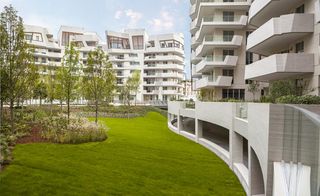
They were also arranged so as to create an internal car-free ‘social space’. 'There is an analogy here to the classic Italian courtyard,' explains Libeskind.
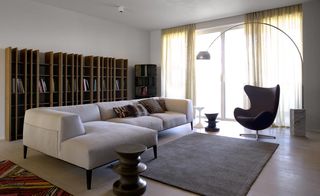
The apartments are all unique in terms of size, exposure and layout, with a choice between two-room or larger family apartments, and penthouses with terraces.
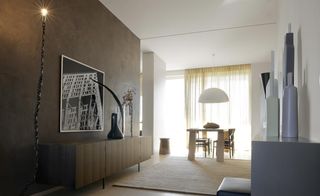
The master plan for the larger site involved keeping and comprehensively refurbishing a few historic structures to transform them into modern apartments.
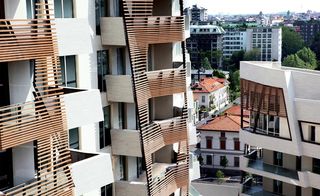
The asymmetrical and faceted glass-and-tile balconies wrap around the buildings creating an expressiveness that is further enhanced by undulating sun-shading louvres made of a bamboo polymer composite.
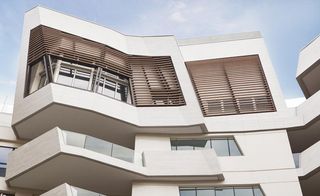
The residential complex’s greatest strength is the buildings’ façades, which are ‘clad’ in a textured and marbled tile developed by innovative Italian ceramics company Casalgrande Padana.
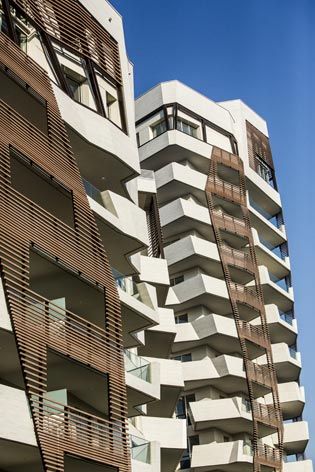
It looks like travertine but is in fact reinforced porcelain and designed to be self-cleaning.
ADDRESS
CityLife
Viale Duilio, 5
(Largo Domodossola) Milan
Italy
Giovanna Dunmall is a freelance journalist based in London and West Wales who writes about architecture, culture, travel and design for international publications including The National, Wallpaper*, Azure, Detail, Damn, Conde Nast Traveller, AD India, Interior Design, Design Anthology and others. She also does editing, translation and copy writing work for architecture practices, design brands and cultural organisations.
-
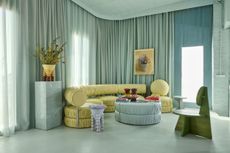 Spanish design studio Masquespacio's new HQ is a historical mansion bursting with colour
Spanish design studio Masquespacio's new HQ is a historical mansion bursting with colourDesign studio Masquespacio presents its new home and office, a bold and unique space in a beautifully refurbished historic villa near Valencia
By Léa Teuscher Published
-
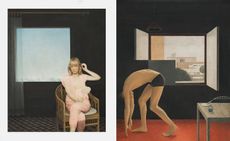 Surreal, uncanny, seductive: step into Graham Little’s world
Surreal, uncanny, seductive: step into Graham Little’s worldScottish artist Graham Little presents his first US retrospective at The FLAG Art Foundation in New York
By Hannah Silver Published
-
 Junya Ishigami designs at Maniera Gallery are as ethereal as his architecture
Junya Ishigami designs at Maniera Gallery are as ethereal as his architectureJunya Ishigami presents new furniture at Maniera Gallery in Belgium (until 31 August 2024), following the series' launch during Milan Design Week
By Ellie Stathaki Published
-
 Giovanni Michelucci’s dramatic concrete church in the Italian Dolomites
Giovanni Michelucci’s dramatic concrete church in the Italian DolomitesGiovanni Michelucci’s concrete Church of Santa Maria Immacolata in the Italian Dolomites is a reverently uplifting memorial to the victims of a local disaster
By Jonathan Glancey Published
-
 Milan’s 10 Corso Como revamp nods to the concept store’s industrial character
Milan’s 10 Corso Como revamp nods to the concept store’s industrial characterMilanese concept store 10 Corso Como unveils its new look by 2050+, a stripped-back design that nods to its 20th-century character
By Ellie Stathaki Published
-
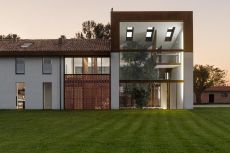 Carlo Ratti announced curator of Venice Architecture Biennale 2025
Carlo Ratti announced curator of Venice Architecture Biennale 2025Carlo Ratti has been revealed as the Director of the Architecture Department at the Venice Architecture Biennale 2025, with the specific task of curating the 19th International Architecture Exhibition
By Ellie Stathaki Published
-
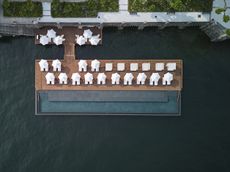 Floating infinity pool by Herzog & De Meuron at Lake Como is largest of its kind
Floating infinity pool by Herzog & De Meuron at Lake Como is largest of its kindHerzog & de Meuron creates the largest floating infinity pool in the world for Mandarin Oriental in Lake Como
By Lauren Ho Published
-
 Freddy Mamani on Neo-Andean architecture and bringing a cruise ship to Bolivia
Freddy Mamani on Neo-Andean architecture and bringing a cruise ship to BoliviaWe catch up with Bolivian architect Freddy Mamani at Focus: Radical Repair, the conference curated by The World Around and Fondation Cartier in Milan, to talk about Neo-Andean architecture and his latest project, el Crucero de los Andes
By Laura May Todd Published
-
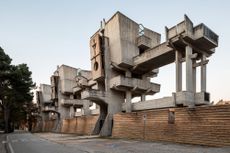 Best of brutalist Italian architecture chronicled in new book
Best of brutalist Italian architecture chronicled in new bookBrutalist Italian architecture enthusiasts and concrete completists will be spoilt for choice by Roberto Conte and Stefano Perego’s pictorial tour
By Jonathan Bell Published
-
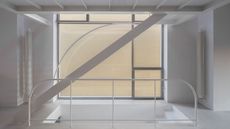 Studio Tropicana, Switzerland and Italy: Wallpaper* Architects’ Directory 2023
Studio Tropicana, Switzerland and Italy: Wallpaper* Architects’ Directory 2023Based in Switzerland and Italy, Studio Tropicana is part of the Wallpaper* Architects’ Directory 2023, our annual round-up of exciting emerging architecture studios
By Ellie Stathaki Published
-
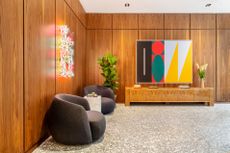 WeWork Meravigli blends past and present in a 21st-century office space
WeWork Meravigli blends past and present in a 21st-century office spaceWeWork Meravigli launches in Milan, bringing its ornate, historical new home to the 21st century
By Ellie Stathaki Published